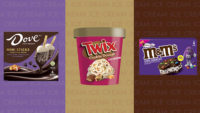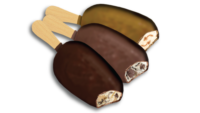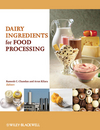Yogurt versus Ice Cream
Frozen yogurt is picking up steam and might just require more room on the freezer shelf soon.

September 13/Chicago/Press Release -- Through familiarity and array of offerings, ice cream is the leading frozen treat in the ice cream and frozen novelty market, representing 54% of sales in 2013. However, according to new research from Mintel, frozen yogurt is picking up steam and might just require more room on the freezer shelf soon. Indeed, due largely to new product releases that are spurred by consumer interest in health and the popularity of yogurt offerings in the foodservice arena, frozen yogurt sales saw a 74% increase between 2011-13, a monumental increase compared to the minimal 3.9% increase of ice cream.
Overall, sales of ice cream and frozen novelties grew 9% from 2008-13 to $11.2 billion, equating to a loss of 1% when adjusted for inflation. While ice cream is the most popular segment by far in the sector (consumed in 89% of U.S. households according to Mintel’s research) the segment posted minimal sales growth, going from $5.7 billion in 2011 to $5.9 billion in 2013. In contrast, the frozen yogurt sector grew from $279 million in 2011 to reach $486 million in 2013.
Beth Bloom, food and drink analyst at Mintel, said, “While ice cream remains the largest segment of the ice cream and frozen novelties market, sales dipped following the economic downturn. The expanding array of snack options, as well as a lack of product innovation, contributed to this performance. In contrast, the frozen yogurt segment has benefitted from a perfect storm of factors, including the growing popularity of yogurt among US consumers, the growing acceptance of frozen yogurt as a snack, and a perception of a higher health profile that coincides with increased attention placed on better-for-you products.”
The majority of consumers (73%), believe that ice cream and frozen novelties can fit into a healthy lifestyle and nearly half (47%) agree that low sugar/fat ice cream and frozen treats are as satisfying as regular varieties. However, some 53% of consumers say they try to limit the amount of ice cream or frozen treats they keep around the house because they are afraid they will eat too much and 21% believe eating these items even once a week is too excessive.
More than half (56%) of all ice cream and frozen novelty consumers partake in their sweet treat after a meal as a dessert, however younger Americans believe anytime is good for a cold treat. Indeed, 57% of those between 18-24 years old eat ice cream/frozen novelties whenever they want compared to 44% of all age groups. In addition, 30% of 18-24s indulge on frozen treats as a snack between meals versus only 22% of all ages. This is perhaps understandable as Mintel’s research shows that young consumers are twice as likely as the average to eat products for mood enhancement (38% vs. 19%).
“Ice cream and frozen novelty products positioned as having an added value through the offer of functional benefits, as well as reduced guilt through their contribution to wellbeing, can stand apart from the competition on store shelves and garner more attention from consumers,” adds Bloom.
Perhaps a benefit of living alone, respondents from single-person households are more likely than larger households to eat frozen treats whenever they want (52% vs. 44%). According to Bloom, “this is a strong indication that advertisements that depict people reveling in the solo enjoyment of ice cream and frozen treat products should resonate with a large percentage of consumers.”
Overall, sales of ice cream and frozen novelties grew 9% from 2008-13 to $11.2 billion, equating to a loss of 1% when adjusted for inflation. While ice cream is the most popular segment by far in the sector (consumed in 89% of U.S. households according to Mintel’s research) the segment posted minimal sales growth, going from $5.7 billion in 2011 to $5.9 billion in 2013. In contrast, the frozen yogurt sector grew from $279 million in 2011 to reach $486 million in 2013.
Beth Bloom, food and drink analyst at Mintel, said, “While ice cream remains the largest segment of the ice cream and frozen novelties market, sales dipped following the economic downturn. The expanding array of snack options, as well as a lack of product innovation, contributed to this performance. In contrast, the frozen yogurt segment has benefitted from a perfect storm of factors, including the growing popularity of yogurt among US consumers, the growing acceptance of frozen yogurt as a snack, and a perception of a higher health profile that coincides with increased attention placed on better-for-you products.”
The majority of consumers (73%), believe that ice cream and frozen novelties can fit into a healthy lifestyle and nearly half (47%) agree that low sugar/fat ice cream and frozen treats are as satisfying as regular varieties. However, some 53% of consumers say they try to limit the amount of ice cream or frozen treats they keep around the house because they are afraid they will eat too much and 21% believe eating these items even once a week is too excessive.
More than half (56%) of all ice cream and frozen novelty consumers partake in their sweet treat after a meal as a dessert, however younger Americans believe anytime is good for a cold treat. Indeed, 57% of those between 18-24 years old eat ice cream/frozen novelties whenever they want compared to 44% of all age groups. In addition, 30% of 18-24s indulge on frozen treats as a snack between meals versus only 22% of all ages. This is perhaps understandable as Mintel’s research shows that young consumers are twice as likely as the average to eat products for mood enhancement (38% vs. 19%).
“Ice cream and frozen novelty products positioned as having an added value through the offer of functional benefits, as well as reduced guilt through their contribution to wellbeing, can stand apart from the competition on store shelves and garner more attention from consumers,” adds Bloom.
Perhaps a benefit of living alone, respondents from single-person households are more likely than larger households to eat frozen treats whenever they want (52% vs. 44%). According to Bloom, “this is a strong indication that advertisements that depict people reveling in the solo enjoyment of ice cream and frozen treat products should resonate with a large percentage of consumers.”
Looking for a reprint of this article?
From high-res PDFs to custom plaques, order your copy today!







